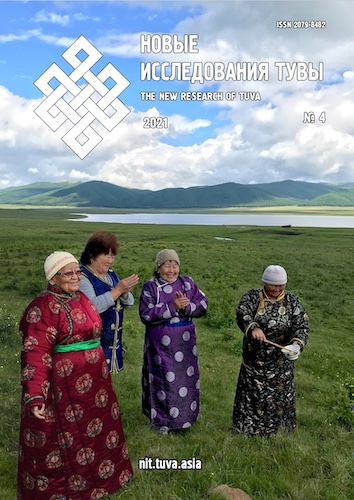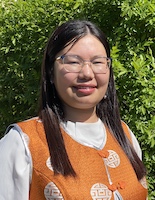The History of the Kinship Group of Kuzhuget from the Barun-Khemchik District of Tuva
DOI:
https://doi.org/10.25178/nit.2021.4.3Keywords:
Tuvans; history of Tuva; passportization; lineage group; kinship group; family rite; family tree; Kuzhuget; KhomushkuAbstract
The article presents an example of a study of the restoration of the relations between Tuvan kin groups whose history in the 20th century was turbulent and full of breaks in family ties. The author tells the story of her kin group of Kuzhuget on the side of her mother who was native to the village of Khondelen in the Barun-Khemchik district. The family tree of the kin group of Kuzhuget is presented and the facts of adoption are noted, as well as the consequences of passportization in Tuva in the 1940s.
The author in particular discusses the issue of the internal migration (within Tuva) among the members of the kinship group. Today the relatives live mainly in the Barun-Khemchik and Tandinsky districts of Tuva. This has had a certain influence on the maintenance of family ties.
The article examines the issues of the strengthening of relations (through online communication) and also notes the role of ancestral rites which are conducted by the kinship groups in the two districts.
References
Belkov, P. L. (2013) Avstraliiskie sistemy rodstva. Osnovy tipologii i elementarnye preobrazovaniia [Australian kinship systems. Basics of typology and elementary transformations]. St. Petersburg, Nauka Publ. 156 p. (In Russ.).
Burykin, A. A. and Popov, V. A. (2020) Russkaia terminologiia rodstva i svoistva: istoricheskaia dinamika, aksiologicheskie polia, kommunikativnyi diskurs [Russian terminology of kinship and properties: Historical dynamics, axiological fields, communicative discourse]. St. Petersburg, Peterburgskoe vostokovedenie Publ. 320 p. (In Russ.).
Biche-ool, S. M. (2018) Traditsionnye brachno-semeinye otnosheniya u tuvintsev i ikh transformatsiya v sovetskii period [Traditional matrimonial and family relations among the Tuvans and their transformation during the Soviet era]. Abakan, Zhurnalist Publ. 125 p. (In Russ.).
Weinstein, S. I. (1959) Rod i kochevaia obshchina u vostochnykh tuvintsev (XIX — nachalo XX v.) [The clan and nomadic community of the Eastern Tuvans (19th — early 20th century)]. Sovetskaia etnografiia, no. 6, pp. 80–86. (In Russ.).
Weinstein, S. I. (1961) Tuvintsy-todzhintsy. Istoriko-etnograficheskie ocherki [Tozhu Tuvans: Historical and ethnographic essays]. Moscow, Nauka Publ. 218 p. (In Russ.).
Weinstein, S. I. (1969) Proiskhozhdenie i istoricheskaia etnografiia tuvinskogo naroda [The origin and historical ethnography of the Tuvan people]: Abstract of the diss. ... Doctor of History. Moscow. 45 p. (In Russ.).
Weinstein, S. I. (2016) Zagadochnaia Tuva [The mysterious Tuva]. Moscow, Domashniaia gazeta Publ. 416 p. (In Russ.)
Dagylga: tuvinskie obriady osviashcheniia v XXI veke [Dagylga: Tuvan rites of consecration in the 21st century] (2021) / ed. by Ch. K. Lamazhaa and N. D. Suvandii. Kyzyl, s. n. 188 p. (In Russ. and Tuv.).
Dyrtyk-ool, A. O. and Khertek, S. S. (2018) Rodoplemennaia gruppa Kuzhuget Bai-Taiginskogo raiona Tuvy [The indigenous group of Kuzhuget in the Bai-Taiginsky district of Tuva]. In: Luchshaia nauchno-issledovatel'skaia rabota 2018 [The best research works of 2018] : A collection of articles of the 12th International research-to-practice competition / ed. by N. Yu. Guliaev. Penza, Publishing House of the International Center for Scientific Cooperation “Nauka i prosveshchenie”. 352 p. Pp. 80–83. (In Russ.).
Kara-ool, L. S. (2004) Terminy rodstva i svoistva v tuvinskom iazyke [Kinship and in-law terms in the Tuvan language] : Abstract of the Diss. … Candidate of Philology. Moscow. 24 p. (In Russ.).
Kara-ool, L. S. (2006) Terminy rodstva i svoistva v tuvinskom iazyke [Kinship and in-law terms in the Tuvan language]. Kyzyl, Editorial and Publishing Department at Tuvan State University. 252 p. (In Russ.).
Kenin-Lopsan, M. B. (1994) Tyva chonnuӊ burungu uzhurlary [Traditional ethics of Tuvans]. Kyzyl, Novosti Tuvy Publ. 192 p. (In Tuv.).
Kon, F. Ya. (1934) Za piat'desiat let [In fifty years] : Collected works : [in 3 vols.]. Moscow : Publishing House of the All-Union Society of Political Prisoners and Exiled Settlers. Vol. 3: Ekspeditsiia v Soiotiiu [An expedition to Soyotia]. 293 p. (In Russ.).
Kretser, I. Yu. (2016) V poiskakh rodstva: k postanovke problemy izucheniia rodstvennykh otnoshenii v sovremennykh zapadnykh issledovaniiakh [Searching for kinship: Towards a problem statement in contemporary western kinship studies]. The Journal of Sociology and Social Anthropology, vol. 19, no. 1, pp. 166–180. (In Russ.).
Kuzhuget, A. K. (2006) Dukhovnaia kul'tura tuvintsev. Struktura i transformatsiia [The immaterial culture of Tuvans. Structure and transformation]. 2nd ed., enlarged. Krasnoyarsk, Ofset Publ. 320 p. (In Russ.).
Kuzhuget, Sh. Yu., Suvandii, N. D., Dambaa, Sh. V. and Lamazhaa, Ch. K. (2019) Kontsept törel ‘rodstvennik’ v iazykovoi kartine mira tuvintsev [The concept of төрел ('relative') in the Tuvan linguistic world picture]. New Research of Tuva, no. 3, pp. 149–157. (In Russ.). DOI: https://doi.org/10.25178/nit.2019.3.12
Lamazhaa, Ch. K. (2013) Arkhaizatsiia obshchestva. Tuvinskii fenomen [Archaization of the society. Tuvan phenomenon]. Moscow, Knizhnyi dom “Librokom”. 272 p. (In Russ.)
Lamazhaa, Ch. K. (2017) Problemy opredeleniia i issledovaniia subetnicheskikh grupp tuvintsev [Sub-ethnic groups of the Tuvans : problems of definition and research]. New Research of Tuva, no. 1, pp. 4–21. (In Russ.). DOI: https://doi.org/10.25178/nit.2017.1.1
Lamazhaa, Ch. K. (2021a) Sotsial'naia kul'tura tuvintsev i onlain-prostranstvo [Social culture of Tuvans and online space]. New Research of Tuva, no. 2, pp. 115–129. (In Russ.). DOI: https://doi.org/10.25178/nit.2021.2.10
Lamazhaa, Ch. K. (2021b) Tuvinskie obriady dagylga v XXI veke [Tuvan rites dagylga in the 20th century]. Etnograficheskoe obozrenie, no. 2, pp. 125–143. (In Russ.). DOI: https://doi.org/10.31857/S086954150014811-2
Lamazhaa, Ch. K. and Namrueva, L. V. (2018) Subetnicheskie differentsiatsii rossiiskikh etnosov (na primere kalmykov i tuvintsev) [Sub-ethnic differentiations of Russian ethnic groups: The case of Kalmyks and Tuvans]. New Research of Tuva, no. 2, pp. 206–226. (In Russ.). DOI: https://doi.org/10.25178/nit.2018.2.11
Mannai-ool M. Kh. (2004) Tuvintsy: proiskhozhdenie i formirovanie tuvinskogo etnosa [Tuvans: The origin and formation of the Tuvan ethnos]. Novosibirsk, Nauka Publ. 166 p. (In Russ.).
Miličić, B. (2010) Izuchenie rodstva, simvolicheskoe myshlenie i preistoriia v antropologii XXI veka [Kinship studies, symbolic thought, and prehistory in the 21st century anthropology]. Stratum Plus, no. 2, pp. 15–21. (In Russ.).
Ocherki sotsial'nogo razvitiia Tuvinskoi ASSR [Essays on social development of the Tuvan ASSR] (1983) / V. I. Boiko, V. N. Beloshapkina, G. Ch. Shirshin et al. ; ed. by Yu. L. Aranchyn. Novosibirsk, Nauka Publ. 262 p. (In Russ.).
Potapov, L. P. (1969) Ocherki narodnogo byta tuvintsev [The Tuvans: Sketches of the folk lifestyle and related household activities]. Moscow, Nauka Publ. 402 p. (In Russ.).
Prokofieva, E. D. (2011) Protsess natsional'noi konsolidatsii tuvintsev [The process of the national consolidation of the Tuvans]. St. Petersburg, Nauka Publ. 538 p. (In Russ.).
Pchelov, E. V. (2000) Teoreticheskie poniatiia genealogii [Theoretical concepts of genealogy]. Gerboved, no. 45, pp. 54–61. (In Russ.).
Sevek, V. K., Taibyl, R. S. and Darzhaa, Ch. B. (2020) Analiz ekonomicheskoi effektivnosti tipovykh etnicheskikh khoziaistv Respubliki Tyva [Analysis of economic efficiency of typical ethnic farms of the Republic of Tuva]. Nauchnye trudy Vol'nogo ekonomicheskogo obshchestva Rossii, vol. 223, no. 3, pp. 468–477. (In Russ.). DOI: https://doi.org/10.38197/2072-2060-2020-223-3-468-477
Starikova, G. I. (2021) Lokal'naia istoriia i genealogiia (na primere kazach'ego roda Zavarukhinykh iz stanitsy Magnitnoi) [Local history and genealogy (The case of the Cossack family of the Zavarukhins from the village of Magnitnaya)]. In: Genealogiia i arkhivy [Genealogy and archives] : Proceedings of the Third All-Russian research-to-practice conference / ed. by N. A. Antipin. Chelyabinsk, State Institution “United State Archive of the Chelyabinsk Region”. 427 p. Pp. 384–390. (In Russ.).
Stépanoff, Ch. (2009) Metamorfozy rodstva u tuvintsev [Metamorphoses of kinship among Tuvans]. Etnograficheskoe obozrenie, no. 4, pp. 129–145. (In Russ.).
Suvandii, N. D. (2011) Tuvinskaia antroponimiia [Tuvan anthroponymy]. Kyzyl, Editorial and Publishing Department at Tuvan State University. 207 p. (In Russ.).
Tatarintsev, B. I. (2009) O nekotorykh tuvinskikh etnonimakh [About some Tuvan ethnonyms]. In: Tatarintsev, B. I. Izbrannye nauchnye trudy [Selected scientific works]. Kyzyl, Tyvapoligraf Publ. 287 p. Pp. 164–169. (In Russ.).
Chistik, Zh. K. (2010) Ekologicheskaia kul'tura tuvinskogo etnosa [Ecological culture of the Tuvan ethnic group]. Kyzyl, Tuvan Book Publisher. 176 p. (In Russ.)
Yakovlev, E. K. (1900) Semeinyi i obshchestvennyi byt u soiot: rody, stepeni rodstva, brak i polozhenie zhenshchiny, razvod, naselenie, pokhorony [Family and social life of the Soyot: Birth, degree of kinship, marriage and status of women, divorce, population and funeral]. In: Yakovlev, E. K. Etnograficheskii obzor inorodcheskogo naseleniia doliny Yuzhnogo Eniseia i ob"iasnitel'nyi katalog etnograficheskogo otdela muzeia [An ethnographic review of the South Yenisei Valley and the explanatory catalogue of the Museum’s Ethnography Research Department]. Minusinsk, V. I. Kornakov’s Printing House. 357 p. Pp. 79–99. (In Russ.).
Read, D. W (2007) Kinship theory: A paradigm shift. Ethnology, vol. 46, no. 4, pp. 329–364.
Read, D. W. (2009) Another look at kinship: Reasons why a paradigm shift is needed. In: Algebra rodstva [Algebra of kinship]. Issue 12 / ed. by V. A. Popov. St. Petersburg, Museum of Anthropology and Ethnography of RAS. Pp. 42–69.
Published
How to Cite
For citation:
Kuzhuget Sh. Yu. Istoriia rodstvennoi gruppy kuzhuget iz Barun-Khemchikskogo raiona Tuvy [The History of the Kinship Group of Kuzhuget from the Barun-Khemchik District of Tuva]. New Research of Tuva, 2021, no. 4, pp. 31-45. (In Russ.). DOI: https://www.doi.org/10.25178/nit.2021.4.3
Issue
Section

This work is licensed under a Creative Commons Attribution-NonCommercial 4.0 International License.

Author(s) license holder(s) grant rights for their work to the journal (grantee of a license) under the simple non-exclusive open license in accordance with Art. 1286.1 «Open license for a research work, work of literature or fine arts», Civil Code of the Russian Federation.
New Research of Tuva publishes articles under the Creative Commons Attribution-NonCommercial license (CC BY-NC).
Since it is an open license, author(s) reserve the right to upload the article to their institutional repository, submit it to another journal (if it allows republications), or republish it on their own website (in full, or in part).
However, several conditions apply here:
a) The republished version must always contain the name(s) and affiliation(s) of the author(s), the original title and the hyperlink to the original version on the New Research of Tuva website;
b) It must be in open access, free of charge, and no category of readers must be in any way whatsoever advantaged over general readership.
c) should the contribution be submitted elsewhere by its author(s) without substantial modification (30% or more of original text unchanged), the body of the article should contain a disclaimer that the original version was published in New Research of Tuva (with a link to the respective page)
The CC-BY-NC is a non-revocable license which applies worldwide and lasts for the duration of the work’s copyright.









